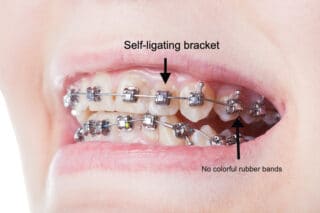
Jacqueline Brown-Bryant, DDS Orthodontics
8737 Colesville Rd.
Suite 301
Silver Spring, MD 20910

More Dental Health Articles
“Self-Ligating” Braces: State-Of-the-Art Orthodontics

Do you wonder why all the media’s attention is focused on self-ligating brackets? Self-ligating (SL) braces have been around for over 20 years and are based on a “low-friction” approach to securing the archwires to the brackets on the teeth allowing orthodontic movement and corrections to occur.
Conventional braces use colored elastics or metal ties to secure, or “ligate” the brackets to the archwire thus creating friction or resistance requiring heavier forces to accomplish tooth movement. With the improved efficiency of self-ligating brackets and high tech wires combined with modernized treatment mechanics, there is little to no friction or resistance when utilizing a closing clip or door mechanism to “ligate” the bracket to the wire consequently requiring lighter forces to move teeth.
Traditional or conventional braces treatment usually requires removal of healthy teeth, use of palatal expanders, and headgears to make space. This approach is often uncomfortable, takes longer, and can leave narrower arches and a smile with a flattened profile.
Faces treated with self-ligation braces are fuller, with a wider natural smile and are achieved with lighter, “biologically-sensible forces” which are more in the lighter, physiologic force ranges of “natural tooth” movement or drift. Teeth tend to drift out of position over a period of time without our sensing or feeling the movement until it is causing dental problems.
Self-ligating braces are considered state-of the-art treatment.
For example, from my experience, treatment with Damon self-ligating brackets can be 4-6 months or 20% shorter in time, require fewer appointments, are more comfortable, hygienic and esthetic because it is a smaller bracket.
Variations in bracket designs and materials (metal or clear) distinguish brackets from each other, however, proper diagnosis, treatment planning and excellent clinical skills are still important in producing extraordinary results with beautiful smiles and faces.
Other Articles You May Find of Interest...
- The Importance of Phase I Orthodontic Treatment for Children Aged 8-10
- Retainers in Riverdale, NY: Choosing the Best Option for Your Smile
- Discover Top-Quality Dental Care in Rockford IL
- Pregnancy & Hormonal Gingivitis: An Essential Guide
- Straighten Your Teeth, Improve Your Health
- Dental Implants For Edentulous Patients
- Dental X-Rays Explained: Procedures, Uses, And Frequency

















